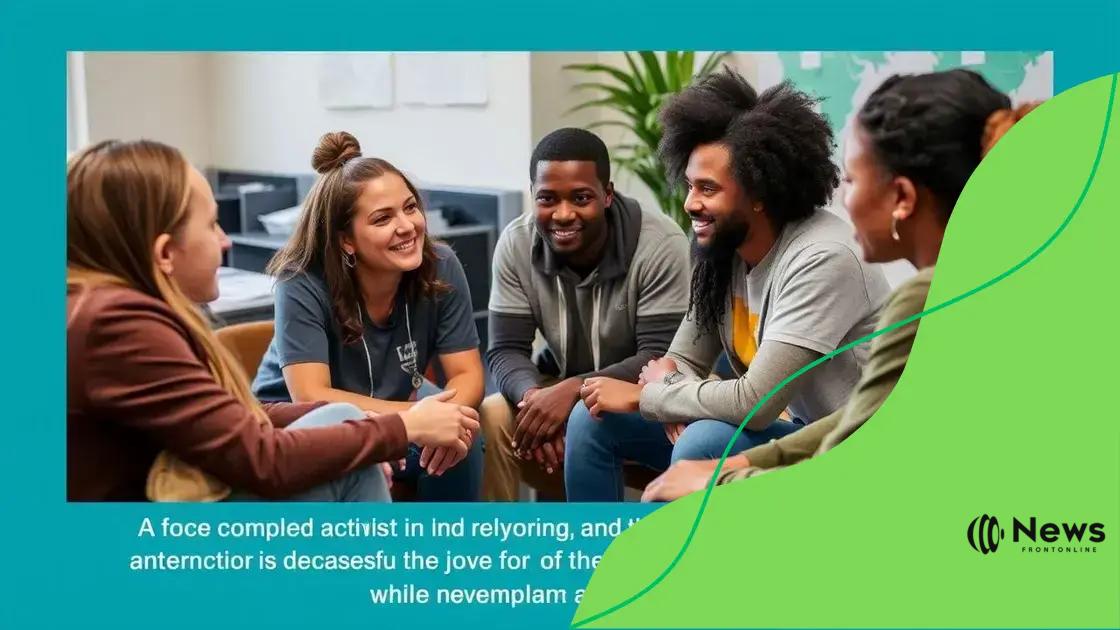Youth-led constitutional campaigns: Empowering change now
Youth-led constitutional campaigns empower young people to advocate for their rights and influence governance by leveraging technology, building networks, and actively participating in decision-making processes.
Youth-led constitutional campaigns are revolutionizing how young people engage with governance. These initiatives empower the next generation to advocate for their rights and influence policy changes. Have you ever wondered how youth can shape their country’s future?
Understanding youth-led constitutional campaigns
Understanding youth-led constitutional campaigns is essential for recognizing how young people can drive significant change in their communities. These campaigns empower youth to take an active role in shaping the policies that affect their lives, allowing them to express their values and priorities. Through these efforts, young leaders can help foster meaningful discussions about constitutional rights and civic engagement.
Key Characteristics of Youth-Led Campaigns
These campaigns often share some common traits. Powerful movements in today’s world are fueled by the energy and passion of young leaders seeking to influence their societies.
- Grassroots involvement: Many youth-led campaigns start from the ground up, encouraging local participation.
- Use of technology: Social media and online platforms play a crucial role in organizing efforts and spreading awareness.
- Focus on education: Informing peers about their rights is a key element of these initiatives.
Moreover, the impact of these campaigns can be profound. For instance, they often bring attention to issues that may be overlooked by traditional political movements. By mobilizing their peers, young activists can create a sense of urgency that resonates with the community, encouraging broader participation in the democratic process.
Examples of Successful Initiatives
Several youth-led constitutional campaigns have gained international attention. Movements around climate change, social justice, and education reform showcase how young people can advocate for change effectively.
They demonstrate the power of youth voices, highlighting their ability to challenge the status quo. Engaging in discussions on such platforms allows for diverse perspectives and innovative solutions to emerge. Each campaign often shares stories of resilience and creativity, showcasing how even a small group can make a tremendous impact.
Overall, youth-led constitutional campaigns are vital for encouraging active citizenship and empowerment among the younger generation. It’s a path toward a more inclusive and participatory democracy, where every voice matters. Embracing the energy of youth and their ideas can lead to transformational change in society.
Key strategies for effective youth engagement
Effective youth engagement is crucial for the success of any campaign, especially those led by young people. Implementing the right strategies can empower them to take action and advocate for their rights and interests. Here are some key techniques that help in fostering this engagement.
Building Strong Networks
Creating a supportive community is essential for youth-led initiatives. When young people connect with their peers, they can share ideas and resources that enhance their efforts.
- Collaborative platforms: Online forums and social media groups are effective for networking and information sharing.
- Involving mentors: Experienced individuals can guide youth and provide valuable insights.
- Participatory events: Organizing workshops and meetups creates a sense of belonging and motivation.
These aspects promote unity and amplify the voices of young activists, enabling them to work collectively toward their goals.
Utilizing Digital Tools
In today’s digital age, technology plays a pivotal role in engaging youth. With the prevalence of smartphones and social media, campaigns can easily reach a wider audience.
Using digital platforms allows for quick dissemination of information, easily mobilizing support for causes. Additionally, engaging content such as videos, memes, and infographics can capture attention and encourage participation.
It’s important to adapt messages to suit various platforms, ensuring that the campaign resonates with different audiences. This targeted approach not only attracts attention but also fosters deeper connections.
By combining these strategies—creating networks and utilizing technology—youth-led campaigns can foster a dynamic environment for advocacy. When young people feel supported and equipped with the right tools, they are more likely to engage actively and make a lasting impact in their communities.
Challenges faced by youth-led initiatives

Youth-led initiatives play a critical role in shaping social change, yet they face several challenges that can hinder their effectiveness. Understanding these obstacles is vital for creating support systems that empower young activists.
Limited Resources
One of the main challenges for youth-led initiatives is the lack of financial resources. Often, young leaders have to rely on small grants or personal funds to support their efforts.
- Funding difficulties: Securing funds can be challenging, leading to limited project scope.
- Materials and tools: Access to necessary materials, such as campaign tools or promotional items, can be constrained.
- Training and development: Young activists may lack access to training programs that could enhance their skills.
These limitations can impede their ability to launch effective campaigns and reach a wider audience.
Societal Perceptions
Another significant barrier is the perception that young people lack the experience needed to lead initiatives. Dismissive attitudes from adults can discourage youth from pursuing their goals. Many young leaders are driven, innovative thinkers who bring fresh ideas to the table.
Combating these stereotypes is critical. Engaging in dialogues with community members can help challenge these perceptions and foster a more inclusive environment.
Furthermore, recognizing the value of youth perspectives is essential for societal growth. As young activists face these challenges head-on, their resilience and creativity can open doors for future initiatives.
Building Support Networks
Despite the challenges, building strong support networks remains crucial for success. When young leaders can connect with mentors and like-minded peers, they are better equipped to navigate obstacles.
Mentorship can provide guidance and encouragement, helping young people to overcome hurdles more effectively. Additionally, collaboration with established organizations can offer valuable insights and resources that strengthen campaigns.
Facilitating support and understanding within the community can empower youth-led initiatives to thrive despite the challenges they may face.
Successful case studies in youth activism
Examining successful case studies in youth activism reveals how young people can drive impactful change. These stories inspire others and provide valuable lessons.
Global Example: The Climate Strikes
The global climate strikes, led by youth activists like Greta Thunberg, showcase the power of young voices. From 2018 onward, students around the world have gathered to protest against inaction on climate change.
- Mobilization: Millions participated, highlighting the urgency of climate issues.
- Media Coverage: The movement gained extensive media attention, amplifying their message.
- Policy Impact: Many governments began to consider climate policies in response to youth pressure.
This movement illustrates how grassroots efforts can spark global conversations and lead to significant policy changes.
Local Impact: Youth-Led Educational Reforms
In many communities, youth-led initiatives have successfully reformed educational systems. One instance is the efforts to advocate for better mental health resources in schools.
Through organized campaigns, young activists have:
- Raised Awareness: Educated peers about mental health challenges.
- Collaborated with Schools: Engaged school administrations to implement supportive programs.
- Formed Partnerships: Worked with local mental health organizations to provide resources.
These initiatives benefit not only current students but also future generations by prioritizing mental health and well-being.
The impact of these successful case studies demonstrates that youth activism can lead to real, meaningful change. They inspire others to join movements for justice and change, reinforcing the value of every voice in shaping a better future.
The future of youth involvement in governance
The future of youth involvement in governance holds great promise as young people become increasingly active in civic matters. Their passion and fresh perspectives can reshape policies and community engagement.
Increased Participation in Decision-Making
Young activists are demanding a place at the table in shaping the policies that affect their lives. Many governments are beginning to recognize this need for inclusion.
- Youth councils: Many cities now have youth councils that advise local governments on issues that impact young people.
- Voting initiatives: Programs aimed at increasing youth voter turnout highlight the importance of their voice in elections.
- Policy advocacy: Young people are increasingly involved in lobbying for issues they care about, from climate action to education reform.
This trend emphasizes that youth can no longer be ignored when discussing governance.
Leveraging Technology for Engagement
Technology plays a pivotal role in engaging youth. Social media platforms allow young people to organize, share information, and mobilize quickly.
This ability to connect online has transformed the landscape of activism. For instance, campaigns can go viral, leading to global movements practically overnight. Additionally, digital tools enable young people to engage with their representatives, making it easier to voice their concerns and suggestions.
As digital natives, youth understand how to leverage these tools to raise awareness and drive engagement on critical issues. This technological proficiency will continue to shape their involvement in governance.
Creating a Culture of Civic Responsibility
Encouraging civic responsibility among young people is crucial. Educational institutions are increasingly focusing on teaching students about civic engagement and leadership.
Programs that emphasize the importance of community involvement prepare youth to be active participants. By fostering a culture of responsibility, we are likely to see a generation of young leaders who prioritize civic duty.
Over time, these shifts reflect a growing acknowledgement that youth involvement is vital for a vibrant democracy. By working together, young people can help forge a government that reflects their aspirations and needs.
FAQ – Frequently Asked Questions about Youth Involvement in Governance
Why is youth involvement in governance important?
Youth involvement ensures that the unique perspectives and needs of younger generations are considered in decision-making processes.
What are some ways young people can get involved in governance?
Young people can participate through youth councils, voting initiatives, advocacy campaigns, and by leveraging technology to organize movements.
How can technology aid youth activism?
Technology enables rapid mobilization, helps spread awareness through social media, and allows for better communication between young activists and their representatives.
What challenges do youth-led initiatives face?
Youth-led initiatives often face hurdles like limited resources, societal perceptions, and the need for strong support networks to succeed.





